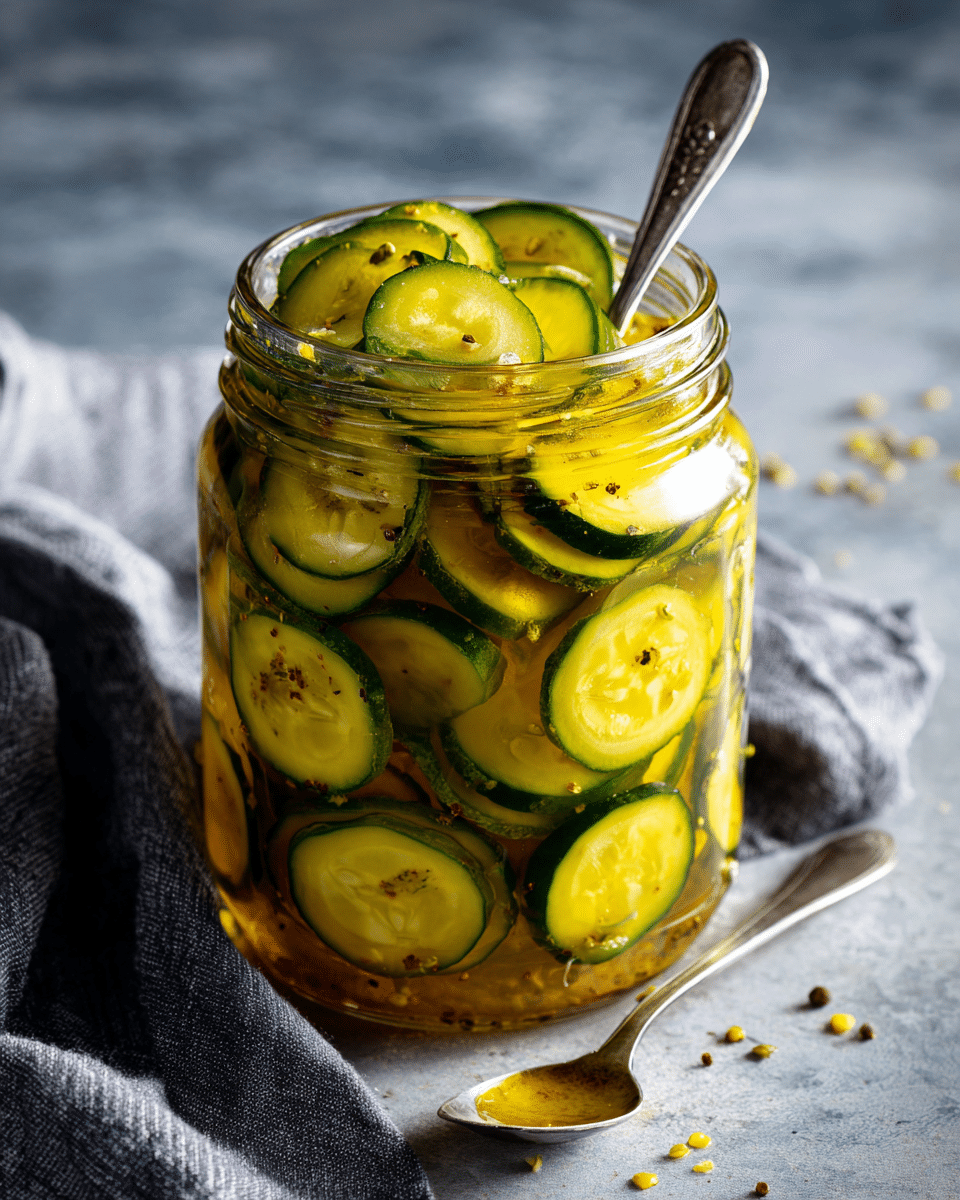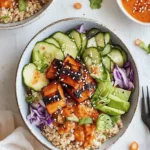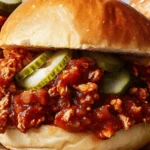These Easy Refrigerator Bread and Butter Pickles are a quick and flavorful way to enjoy homemade pickles without the hassle of traditional canning. Perfectly tangy and sweet, these pickles are ideal for topping burgers, sandwiches, or simply enjoying as a crunchy snack. Made with simple pantry staples and fresh cucumbers, they come together in just a few minutes and are ready to eat after chilling overnight.
FULL RECIPE
Ingredients
- 4 cups thinly sliced pickling cucumbers (about 4–5 small cucumbers)
- 1 cup thinly sliced onion
- 1 tablespoon kosher salt
- 1 cup granulated sugar
- 1 cup white vinegar
- ½ cup apple cider vinegar
- ¼ cup water
- 1 teaspoon mustard seeds
- 1 teaspoon celery seeds
- ½ teaspoon ground turmeric
- ¼ teaspoon crushed red pepper flakes (optional, for mild heat)
Directions
- Place sliced cucumbers and onions in a large bowl. Sprinkle with kosher salt and toss to coat evenly. Let sit for 1 hour at room temperature to draw out excess moisture.
- After 1 hour, rinse the cucumbers and onions thoroughly under cold water to remove the salt. Drain well and set aside.
- In a medium saucepan, combine sugar, white vinegar, apple cider vinegar, water, mustard seeds, celery seeds, turmeric, and crushed red pepper flakes (if using).
- Bring the mixture to a simmer over medium heat, stirring until the sugar is fully dissolved.
- Remove the saucepan from heat and let the brine cool for 5–10 minutes.
- Place the drained cucumbers and onions into clean glass jars (wide-mouth pint jars or quart jars work best).
- Carefully pour the warm brine over the cucumber mixture, ensuring they are fully submerged. Tap the jars gently to release any trapped air bubbles.
- Let the jars cool to room temperature without lids. Once cooled, seal with lids and refrigerate.
- Refrigerate for at least 24 hours before serving for best flavor. Pickles will keep in the refrigerator for up to 3 weeks.
Nutrition Facts
- Calories: 60
- Total Fat: 0g
- Saturated Fat: 0g
- Cholesterol: 0mg
- Sodium: 280mg
- Total Carbohydrates: 15g
- Dietary Fiber: 1g
- Sugars: 13g
- Protein: 0g
The History of Bread and Butter Pickles
Bread and butter pickles have a charming history rooted in American home cooking traditions. The name is believed to originate from the simple pairing of these sweet and tangy pickles with bread and butter sandwiches, a popular staple in the early 20th century. They became especially well-known during the Great Depression as a cost-effective way to preserve cucumbers and extend their shelf life. Over time, the recipe evolved with various regional twists, but the hallmark sweet-sour flavor remains a beloved classic.
What Makes Refrigerator Pickles Different
Refrigerator pickles stand apart from traditional canned pickles primarily because they require no heat processing or sealing for long-term storage. Instead, they rely on refrigeration to maintain freshness and safety. This method is faster and more accessible for home cooks who want fresh-tasting pickles without investing time and equipment in canning. The pickles retain a crisp texture and vibrant flavor, making them ideal for quick consumption within a few weeks.
Health Benefits of Bread and Butter Pickles
While bread and butter pickles are often enjoyed as a flavorful condiment, they also offer some health benefits. Cucumbers, the main ingredient, are low in calories and provide hydration due to their high water content. The pickling process introduces beneficial probiotics when naturally fermented, though refrigerator pickles typically have less fermentation. Additionally, vinegar in the brine has been linked to improved digestion and blood sugar regulation, making these pickles a tasty and potentially health-supportive addition to your diet.
Customizing the Sweetness and Spice Levels
One of the joys of making refrigerator bread and butter pickles is the ability to customize the flavor profile. Some prefer their pickles sweeter, increasing the sugar in the brine, while others enjoy a tangier bite with more vinegar. For those who like heat, adding crushed red pepper flakes or even jalapeño slices can create a spicy kick. Conversely, omitting spices like mustard seeds or celery seeds can yield a milder pickle, allowing the natural cucumber flavor to shine.
Choosing the Right Cucumbers for Pickling
The type of cucumber you select significantly influences the texture and flavor of your pickles. Pickling cucumbers, sometimes labeled as Kirby cucumbers, are small, firm, and have fewer seeds, making them ideal for crisp, crunchy pickles. Avoid using large slicing cucumbers with thick skins, as they can become mushy during the pickling process. Freshness is key—pick cucumbers that are firm and free of blemishes to ensure the best results.
Serving Suggestions and Pairings
Bread and butter pickles are incredibly versatile and pair well with a wide range of dishes. They add a sweet and tangy crunch to classic sandwiches like burgers, pulled pork, or grilled cheese. They also serve as a delightful topping for hot dogs or as a side for barbecue and fried foods, cutting through richness with their acidity. For a creative twist, try incorporating them into salads or chopped up in potato or egg salads to introduce a burst of flavor.
Storage Tips for Maximum Freshness
Because refrigerator pickles are not heat-processed, proper storage is crucial to maintain their quality and safety. Always keep them tightly sealed in clean glass jars and store them in the refrigerator. Consume them within three weeks for the best texture and flavor. Avoid double-dipping or contaminating the jar with utensils to prolong shelf life. If you notice any off smells, discoloration, or mold, discard the pickles immediately.
How to Adjust for Dietary Preferences
This recipe is naturally gluten-free and vegan, making it suitable for many dietary needs. For those watching their sugar intake, consider reducing the sugar amount or substituting with natural sweeteners like honey or stevia, though this will slightly change the flavor and texture. People on low-sodium diets can reduce the salt but should be mindful that it plays an important role in flavor and preservation. Experimenting with these adjustments can help tailor the recipe to individual health goals.
Common Mistakes to Avoid
When making refrigerator bread and butter pickles, some common pitfalls can affect the final product. Not salting the cucumbers long enough or failing to rinse them thoroughly can result in overly salty or mushy pickles. Using the wrong type of cucumber or letting the brine cool too much before pouring can also impact texture. Ensuring all vegetables are fully submerged in the brine helps prevent spoilage. Paying attention to these details will improve both flavor and shelf life.
Creative Variations to Try
Beyond the classic recipe, there are many creative variations to experiment with. Adding fresh dill, garlic cloves, or ginger can introduce new layers of flavor. For a Mediterranean twist, try incorporating herbs like oregano or thyme. You might also experiment with different types of vinegar, such as balsamic or rice vinegar, to alter the acidity and sweetness balance. These variations keep the basic method intact but allow for personalized flavor experiences.
Conclusion
Easy Refrigerator Bread and Butter Pickles offer a simple and rewarding way to enjoy homemade pickles without the need for canning equipment or lengthy preparation. Their sweet and tangy flavor, combined with a satisfying crunch, makes them a versatile addition to many meals. By understanding the history, health benefits, and tips for customization and storage, home cooks can confidently make and enjoy this classic recipe. Whether as a condiment, snack, or salad ingredient, these pickles bring freshness and zest to your table all year round.






